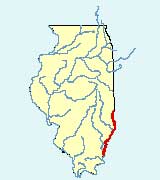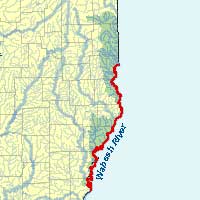Choose another river
Wabash River


©Illinois State Water Survey
Location: The Wabash River originates near Fort Recovery, Ohio. It flows southwest for 500 miles through Indiana and forms the boundary between Indiana and Illinois until it meets the Ohio River above Old Shawneetown, Illinois. It has a total drainage of 33,000 square miles, of which about two-thirds is agricultural. Approximately one-fourth of its drainage comes from Illinois. The Wabash is one of the largest free-flowing rivers east of the Mississippi River. It flows unimpeded for over 400 miles from the Huntington Dam in Indiana to its confluence with the Ohio. The Wabash does not have commercial navigation.
The Illinois portion of the Wabash River, which is over 200 miles long, starts about 9 miles above Darwin, Illinois or about 15 miles below Terre Haute, Indiana. It continues its course south, picking up drainage from the Embarras River south of Vincennes, Indiana. At Mt. Carmel, Illinois, the White River, which drains a large portion of Indiana, enters the Wabash. At this point the Wabash nearly doubles in size and continues its course, receiving drainage from the Little Wabash near New Haven, Illinois. From this point the Wabash flows another 15 miles and ends at Wabash Island on the Ohio.
Description: Because of its unique qualities for a large river in Illinois, the Wabash supports a diverse fishery. Fish species range from small, endangered darters to large paddlefish. Sport species present include blue catfish, channel catfish, flathead catfish, white bass, striped bass, hybrid striped bass, smallmouth bass, spotted bass, largemouth bass, white crappie, black crappie, bluegill, freshwater drum and sauger. Common, exotic grass, bighead, grass and silver carp are also present.
Angling success can occur anywhere on the river, but a few places known for their fishing include the following areas: the stretch of river around Darwin, Illinois; the area along Vincennes, Indiana; the stretch of river at Mt. Carmel, Illinois; the area at New Harmony, Indiana; the area at the mouth of the Little Wabash River near New Haven, Illinois; and the stretch of river below Maunie, Illinois. The mouth of the Wabash River above Old Shawneetown, Illinois is also a good area to check out.
Boat access to the river can be found at the public boat ramps on the Illinois and Indiana sides of the Wabash. Public ramps on the Illinois side can be found at Hutsonville, Westport, St. Francisville, Mt. Carmel, Grayville, Brown's Pond near Maunie, and New Haven via the Little Wabash River.
Unlike other large Illinois rivers, the Wabash River is unique in that it has no navigation channel. Depending on river stage, the depth of the water can vary from 6 inches to 50 feet and can be rather challenging to boaters not familiar with the river. There are areas on the river at lower river stages that cannot be traversed by boat.
The uniqueness of the Wabash River and it's diverse fishery provide the angler with many rewarding experiences that cannot be found on other Illinois waters.
Recent Research: Read about the recent research being conducted on flathead catfish in the wabash river.
Species |
Rank |
Fish Status |
Excellent | Catfish provide the best opportunities for the angler and can be found throughout the river's entire length. | |
Fair | Although present in the river, fishing opportunities for bluegill is best in the oxbow lakes along the river, which were formed when the river cut off large bends. A large oxbow lake accessible to the public can be found at Grayville, Illinois. | |
Excellent | Catfish provide the best opportunities for the angler and can be found throughout the river's entire length. | |
Excellent | Catfish provide the best opportunities for the angler and can be found throughout the river's entire length. | |
Good | Good Sauger can be taken from throughout the river's entire length. The best time to find sauger is late February through early April off the numerous sandbars and around the fast water riffle areas. | |
Good | Smallmouth bass are found in the upper 100 miles of the river and spotted bass throughout its length. | |
Good | The white, striped and hybrid striped bass can be found throughout the river's length but are more numerous in the lower 100 miles. Best times to seek these fish seem to be in the late spring early summer times around the numerous sandbars found in the lower river and near the fast water riffle areas. | |
Fishing Reports
Fishing Reports can be found for the following areas along the Wabash:



